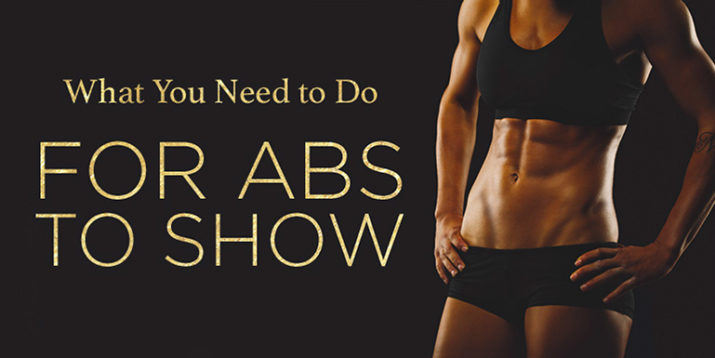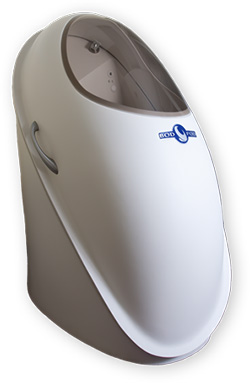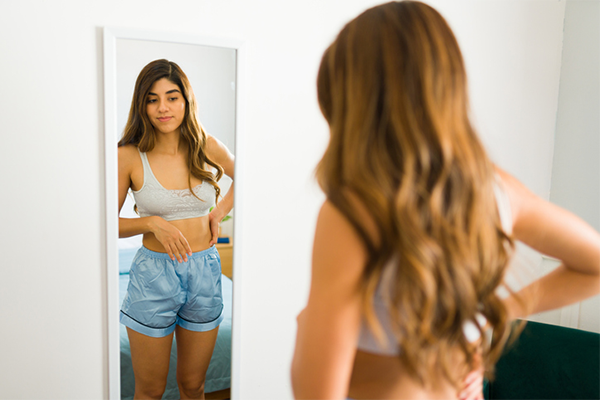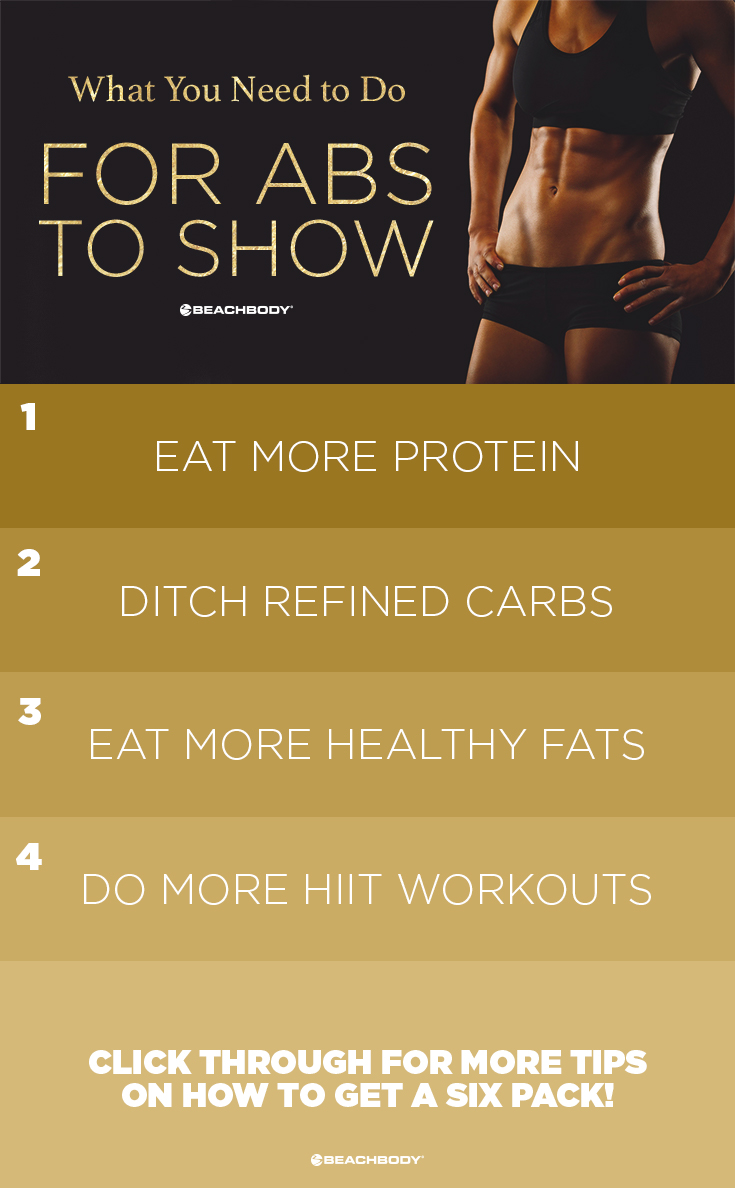How to Get Your Abs to Show

I’ve got some great news for you. You’ve got a killer six-pack. Really! It’s what enables you to flex your spine, hold vital organs in place and lift heavy weights.
Chances are, though, you’d actually like your abs to show. There’s only one thing standing in the way: adipose tissue, a.k.a. fat.
This led me to wonder: How low does my body-fat percentage have to be for my core to be tight? How long does it take to get abs to show?
To find out, I visited the Metabolic, Body Composition and Sport Performance Clinic at Mount Sinai St. Luke’s Hospital in New York City.
What I learned is that there’s no easy answer, and that getting abs to show will require a long-term commitment.
How to Measure Body Composition

I’m met by clinic coordinator Kate Bishop. She has offered to help me with an accurate body composition reading using an intriguing piece of equipment called the BOD POD.
A certified exercise physiologist and strength and conditioning specialist, Bishop explains that there are several standard ways to measure body fat.
Not surprisingly, the more accessible and less expensive the equipment, the less accurate the readings tend to be.
“Calipers are by far the cheapest and easiest way to get a body comp measurement,” she says, adding that they’re best when used to test frequently by the same technician under the same circumstances every time.
According to the American College of Sports Medicine, this method ends up having a margin of error of plus or minus 3.5 percent.
As I was to find out, this can mean the difference between abs being revealed or remaining covered.
“Calipers are less accurate when measuring obese or extremely lean individuals,” Bishop says.
There are plenty of bioelectrical impedance scales — they look a lot like regular bathroom scales — on the market for less than $50.
But a 2008 study by researchers at McMaster University in Ontario showed that while this quick and simple method can be accurate for measuring body fat in some populations, it’s not so reliable for others, and therefore less useful in broad epidemiological studies.
Bishop describes two methods as “the gold standards in body composition assessment.”
The first is called hydrostatic weighing and involves being dunked in water.
The second, a trademarked contraption called the BOD POD, uses air displacement plethysmography to measure body volume.
Both methods operate on the same basic principle — the BOD POD simply uses air displacement rather than water immersion.
“The BOD POD, in combination with normative formulas based on age, gender, weight, and race, helps estimate body fat and lean mass with a high degree of accuracy,” says Bishop. “Hydrostatic weighing provides similar data but requires much more work.”
I was hungry. I was caffeine deprived. I counted myself lucky that I didn’t also have to be submerged in a swimming pool.
The previous evening Bishop had sent me a set of instructions.
I’d been told to arrive at the clinic with a Speedo, be clean shaven, and not eat or take in caffeine in the hours leading up to my appointment.
“This is to ensure that the reading is as accurate as possible,” Bishop says, handing me a swim cap to put on. “If you’re ready you can get into your Speedo.”
I do as I’m told.
Everyone Carries Fat Differently
Sightly self-conscious in the Speedo, I suggest we each take a guess at how much of me is fat. I go with 18.2 percent.
My guess is based on photographs and drawings of what 10, 15, and 20 percent body fat look like. I added the 0.2 just for fun.
“I actually think it might be a little lower,” she says, pinching a spot at the back of my armpit with her thumb and forefinger. “I would guess around 15 percent, but everybody carries their weight differently based on age, gender, ethnicity, and other factors.”
“Generally, body composition can be affected by genetic predisposition for muscle fiber type and where the body more easily stores adipose tissue. That’s why having the BOD POD is so helpful in getting us an accurate assessment.”
With that, she invites me to sit in a white, bean-shaped pod that looks like something George Jetson might use to teleport to work.
I climb inside and am told to sit still and not speak for 30 seconds. The door is closed and the machine does its thing. There’s a large window at eye-level, so I don’t feel claustrophobic.
After a moment Bishop opens the pod and takes a reading. “Well, your guess was closer,” she says, showing me the report. “Again, everyone carries their fat differently.”
It turns out that 17.8 percent of me is fat. In other words, at 154.38 pounds, 27.437 pounds of me — equivalent to more than six two-liter bottles of soda — is blubber.
What’s the Body Fat Percentage Needed for Abs to Show?

“High body-fat risk” starts with a body-fat percentage greater than 30 percent in men and more than 40 percent in women.
Get that reading and you’ll also get a recommendation to see your doctor.
“Excess fat” is a category for which I’m only 2.2 percentage points shy of qualifying. This is a range that indicates “excess accumulations of fat”: Twenty to 30 percent for men, 30 to 40 percent for women.
“Moderately lean”: Though 17.8 percent seems like a lot, my body fat percentage puts me in the “moderately lean” range, which, according to the clinic at St. Luke’s, is anywhere between 12.1 to 20 percent for a man in his early 40s.
This is described as a fat level that’s “generally acceptable for good health.
For a woman, the “moderately lean” bracket is higher, 22.1 to 30 percent. “Women need a higher proportion of fat on their bodies to aid in hormone regulation,” Bishop explains.
“Lean”: According to the clinic’s report, if I can get below 12 percent body fat, I will be officially described as lean.
Bishop says at that threshold I’d have the makings of a six pack. This feels doable. At 17.8 percent, I can count the top four abs if the lighting is just right and I squint.
“Lean” for women is slightly more forgiving at anything below 22 percent.
“Ultra lean”: In the unlikely event I get into the 5-8 percent range I’d be in this category, as would a woman with 15 to 18 percent body fat.
This is the fat level often found in elite athletes. Brad Pitt is said to have been around the 5 to 6 percent area when he showed off his physique in Fight Club.
Getting below 5 percent for men or 15 percent for women is considered a health risk characterized by gaunt faces, popping veins, and muscles that look shrink-wrapped in skin.
“So what does my body comp need to be like to see my abs?” I ask.
“We could only have a very rough idea about that seeing as everyone carries their fat differently,” she says. “It might be 15 percent, it could be 11 percent.”
How Fat Loss Works

Now that I know where I’m at with fat, I ask Bishop what I can do to start driving my body fat down while not losing too much muscle.
“If you’re working to get that number down, it’s likely there will be some combination of both fat and lean muscle mass lost,” she says. The appearance of that loss will depend on how I go about it.
Nutrition for abs
- Eat more protein: Consuming enough lean protein promotes fat loss and muscle gain. Pack enough of it into your breakfast, and you can head off the dips that result in late-day snack binges. Adding a daily shake to your regimen is an easy way to fit more protein into your diet.
- Ditch cheap carbs: Trade refined and processed carbs for the high-fiber variety. Simple carbs like pretzels and soda are quickly broken down into sugars that, if not burned promptly, can be converted to body fat. Meanwhile, high-fiber foods like fruits, vegetables, and whole grains keep you fuller with fewer calories and maintain healthy blood sugar levels.
- Consume the right fats: Similar to the sustained satiety you get from high-fiber food, healthy fats, like the unsaturated ones found in avocados and cold water fish, help you feel full for longer and slow the absorption of the aforementioned carbs.
A healthy caloric breakdown that should leave you full and fortified is roughly 40 percent carbohydrates, 30 percent protein, and 30 percent fat.
Read more about how to eat your way to great abs here.
Exercise for abs
It’s a drum that bears re-beating: You can’t spot-reduce fat.
All you can do is perform exercises that efficiently burn it all over your body, and hope the process gets to your stomach sooner than later.
Science shows that cardio plus resistance training is the best way to burn fat, and any regimen dedicated to revealing your abs should incorporate both.
High-intensity interval training
HIIT is any workout that alternates between periods of high intensity and low intensity or rest, and has been found the most effective protocol for losing fat.
Core training
The most effective thing you can do to reveal your abs is lose fat, but it also behooves you to develop the muscles of your abdomen in order to maximize the pop.
The following three moves are a good place to start building a stronger, more muscular core while burning fat by the bucketload.
1. Plank jacks
- Start in forearm plank with your elbows under your shoulders and your body in a straight line from head to heels.
- At the same time, jump both legs out to the side, and then back together. Keep hips stable so they don’t drop or lift up.
- Make this move easier by performing it in a high-plank position, or doing the plank side foot taps exercise (above).
2. Mountain climbers
- Start in a high-plank position.
- Engage your core to pull your right knee in toward your chest so your foot hovers above the ground, and then step back into the plank. Repeat on the other side with your left leg.
- Speed it up, alternating one leg in and then the other.
- Be sure to keep your hips level and fully extend each leg as it comes back out from the center.
- Sit on the ground, balancing on your tailbone with your knees bent about 90 degrees, heels on the ground and feet flexed. Hold your hands together in front of your torso.
- Twist to your right side, bringing your hands down toward your right hip. Then, reverse the moves and twist to your left side.
- Make it extra challenging by speeding it up, lifting your feet off the ground, or holding a light weight in your hands (shown in video above).

